*NURSING > QUESTIONS & ANSWERS > Chapter 48: Assessment and Management of Patients with Obesity (All)
Chapter 48: Assessment and Management of Patients with Obesity
Document Content and Description Below
1. Which statement by the nurse is most likely to help a morbidly obese 22-year-old man in losing weight on a 1000-calorie diet? A) It will be necessary to change lifestyle habits permanently to mai... ntain weight loss. B) You will decrease your risk for future health problems such as diabetes by losing weight now. C) You are likely to notice changes in how you feel with just a few weeks of diet and exercise. D) Most of the weight that you lose during the first weeks of dieting is water weight rather than fat. Ans: C Feedback: Motivation is a key factor in successful weight loss and a short-term outcome provides a higher motivation. A 22-year-old patient is unlikely to be motivated by future health problems. Telling a patient that the initial weight loss is water will be discouraging, although this may be correct. Changing lifestyle habits is necessary, but this process occurs over time and discussing this is not likely to motivate the patient. 2. After the nurse teaches a patient about the recommended amounts of foods from animal and plant sources, which menu selections indicate that the initial instructions about diet have been understood? A) 3 oz of lean beef, 2 oz of low-fat cheese, and a tomato slice B) 3 oz of roasted pork, a cup of corn, and a cup of carrot sticks C) Cup of tossed salad and nonfat dressing topped with a chicken breast D) Half cup of tuna mixed with nonfat mayonnaise and a half cup of celery Ans: B Feedback: This selection is most consistent with the recommendation of the American Institute for Cancer Research that one third of the diet should be from animal sources and two thirds from plant source foods. The other choices all have higher ratios of animal origin foods to plant source foods than would be recommended. 3. Which nursing action is appropriate when coaching obese adults enrolled in a behavior modification program? Test Bank - Brunner & Suddarth's Textbook of Medical-Surgical Nursing 14e (Hinkle 2017) 912 NURSINGTB.COM BRUNNER AND SUDDARTHS TEXTBOOK OF MEDICAL SURGICAL NURSING 14TH EDITION HINKLE TEST BANK A) Having the adults write down the caloric intake of each meal B) Asking the adults about situations that tend to increase appetite C) Suggesting that the adults plan rewards, such as sugarless candy, for achieving their goals D) Encouraging the adults to eat small amounts frequently rather than having scheduled meals Ans: B Feedback: Behavior modification programs focus on how and when the person eats and de-emphasize aspects such as calorie counting. Nonfood rewards are recommended for achievement of weight-loss goals. Patients are often taught to restrict eating to designated meals when using behavior modification. 4. The nurse is coaching a community group for individuals who are overweight. Which participant behavior is an example of the best exercise plan for weight loss? A) Walking for 40 minutes 6 or 7 days/week B) Lifting weights with friends 3 times/week C) Playing soccer for an hour on the weekend D) Running for 10 to 15 minutes 3 times/week Ans: A Feedback: Exercise should be done daily for 30 minutes to an hour. Exercising in highly aerobic activities for short bursts or only once a week is not helpful and may be dangerous in an individual who has not been exercising. Running may be appropriate, but a patient should start with an exercise that is less stressful and can be done for a longer period. Weight lifting is not as helpful as aerobic exercise in weight loss. 5. A few months after bariatric surgery, a 56-year-old man tells the nurse, My skin is hanging in folds. I think I need cosmetic surgery. Which response by the nurse is most appropriate? A) The important thing is that you are improving your health. B) The skinfolds will disappear once most of the weight is lost. C) Cosmetic surgery is a possibility once your weight has stabilized. Test Bank - Brunner & Suddarth's Textbook of Medical-Surgical Nursing 14e (Hinkle 2017) 913 NURSINGTB.COM BRUNNER AND SUDDARTHS TEXTBOOK OF MEDICAL SURGICAL NURSING 14TH EDITION HINKLE TEST BANK D) Perhaps you would like to talk to a counselor about your body image. Ans: C Feedback: Reconstructive surgery may be used to eliminate excess skinfolds after at least a year has passed since the surgery. Skinfolds may not disappear over time, especially in older patients. The response, The important thing is that your weight loss is improving your health, ignores the patients concerns about appearance and implies that the nurse knows what is important. Whereas it may be helpful for the patient to talk to a counselor, it is more likely to be helpful to know that cosmetic surgery is available. 6. After vertical banded gastroplasty, a 42-year-old male patient returns to the surgical nursing unit with a nasogastric tube to low, intermittent suction and a patient-controlled analgesia (PCA) machine for pain control. Which nursing action should be included in the postoperative plan of care? A) Offer sips of fruit juices at frequent intervals. B) Irrigate the nasogastric (NG) tube frequently. C) Remind the patient that PCA use may slow the return of bowel function. D) Support the surgical incision during patient coughing and turning in bed. Ans: D Feedback: The incision should be protected from strain to decrease the risk for wound dehiscence. The patient should be encouraged to use the PCA because pain control will improve the cough effort and patient mobility. NG irrigation may damage the suture line or overfill the stomach pouch. Sugar-free clear liquids are offered during the immediate postoperative time to decrease the risk for dumping syndrome. 7. The nurse will be teaching self-management to patients after gastric bypass surgery. Which information will the nurse plan to include? A) Drink fluids between meals but not with meals. B) Choose high-fat foods for at least 30% of intake. C) Developing flabby skin can be prevented by exercise. D) Choose foods high in fiber to promote bowel function. Ans: A Test Bank - Brunner & Suddarth's Textbook of Medical-Surgical Nursing 14e (Hinkle 2017) 914 NURSINGTB.COM BRUNNER AND SUDDARTHS TEXTBOOK OF MEDICAL SURGICAL NURSING 14TH EDITION HINKLE TEST BANK Feedback: Intake of fluids with meals tends to cause dumping syndrome and diarrhea. Food choices should be low in fat and fiber. Exercise does not prevent the development of flabby skin. 8. Which assessment action will help the nurse determine if an obese patient has metabolic syndrome? A) Take the patients apical pulse. B) Check the patients blood pressure. C) Ask the patient about dietary intake. D) Dipstick the patients urine for protein. Ans: B Feedback: Elevated blood pressure is one of the characteristics of metabolic syndrome. The other information also may be obtained by the nurse, but it will not assist with the diagnosis of metabolic syndrome. 9. When teaching a patient about testing to diagnose metabolic syndrome, which topic would the nurse include? A) Blood glucose test B) Cardiac enzyme tests C) Postural blood pressures D) Resting electrocardiogram Ans: A Feedback: A fasting blood glucose test >100 mg/dL is one of the diagnostic criteria for metabolic syndrome. The other tests are not used to diagnose metabolic syndrome although they may be used to check for cardiovascular complications of the disorder. 10. What information will the nurse include for an overweight 35-year-old woman who is starting a weightloss plan? A) Weigh yourself at the same time every morning and evening. Test Bank - Brunner & Suddarth's Textbook of Medical-Surgical Nursing 14e (Hinkle 2017) 915 NURSINGTB.COM BRUNNER AND SUDDARTHS TEXTBOOK OF MEDICAL SURGICAL NURSING 14TH EDITION HINKLE TEST BANK B) Stick to a 600- to 800-calorie diet for the most rapid weight loss. C) Low carbohydrate diets lead to rapid weight loss but are difficult to maintain. D) Weighing all foods on a scale is necessary to choose appropriate portion sizes. Ans: C Feedback: The restrictive nature of fad diets makes the weight loss achieved by the patient more difficult to maintain. Portion size can be estimated in other ways besides weighing. Severely calorie-restricted diets are not necessary for patients in the overweight category of obesity and need to be closely supervised. Patients should weigh weekly rather than daily. 11. Which adult will the nurse plan to teach about risks associated with obesity? A) Man who has a BMI of 18 kg/m2 B) Man with a 42 in waist and 44 in hips C) Woman who has a body mass index (BMI) of 24 kg/m2 D) Woman with a waist circumference of 34 inches (86 cm) Ans: B Feedback: The waist-to-hip ratio for this patient is 0.95, which exceeds the recommended level of <0.80. A patient with a BMI of 18 kg/m2 is considered underweight. A BMI of 24 kg/m2 is normal. Health risks associated with obesity increase in women with a waist circumference larger than 35 in (89 cm) and men with a waist circumfere [Show More]
Last updated: 1 year ago
Preview 1 out of 10 pages

Reviews( 0 )
Document information
Connected school, study & course
About the document
Uploaded On
May 22, 2022
Number of pages
10
Written in
Additional information
This document has been written for:
Uploaded
May 22, 2022
Downloads
0
Views
36

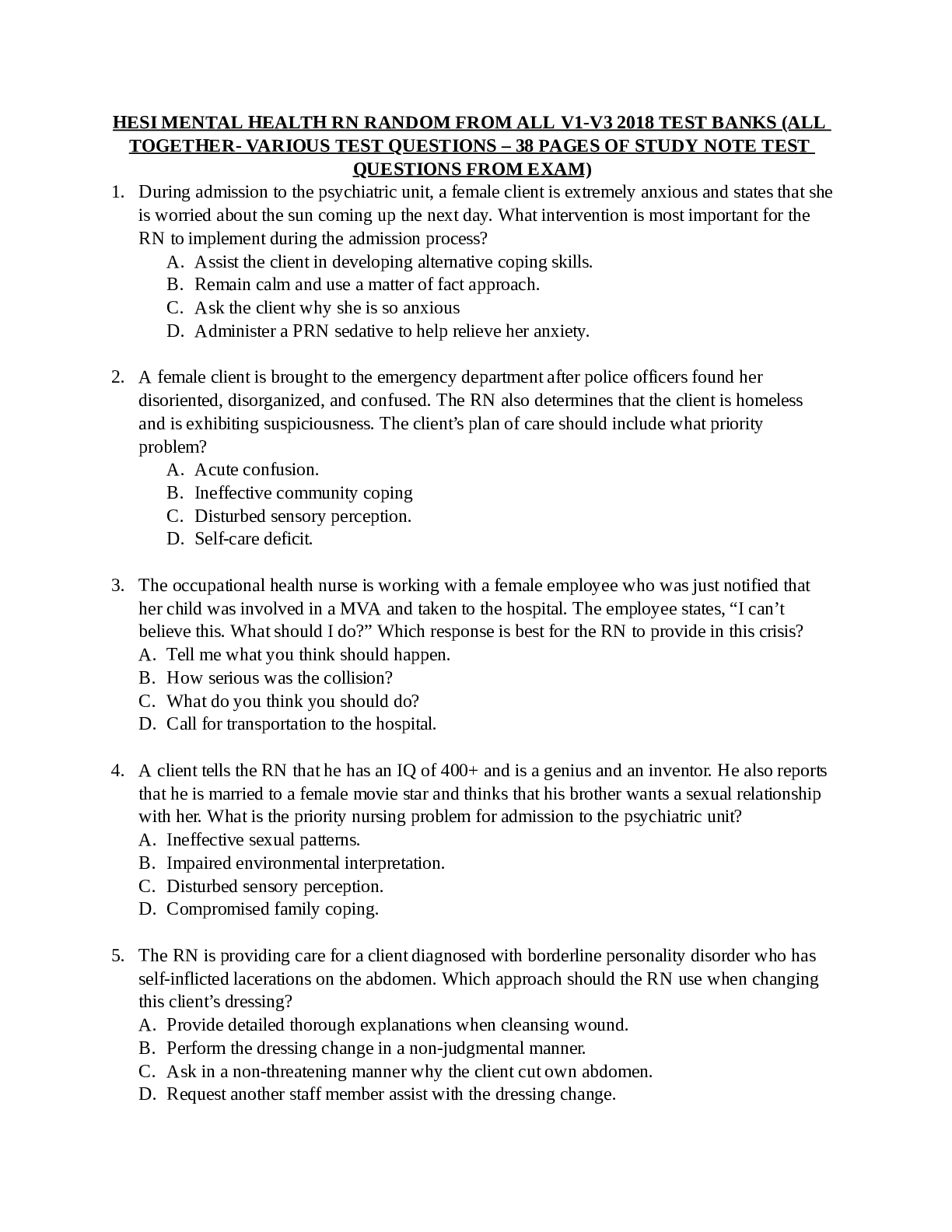

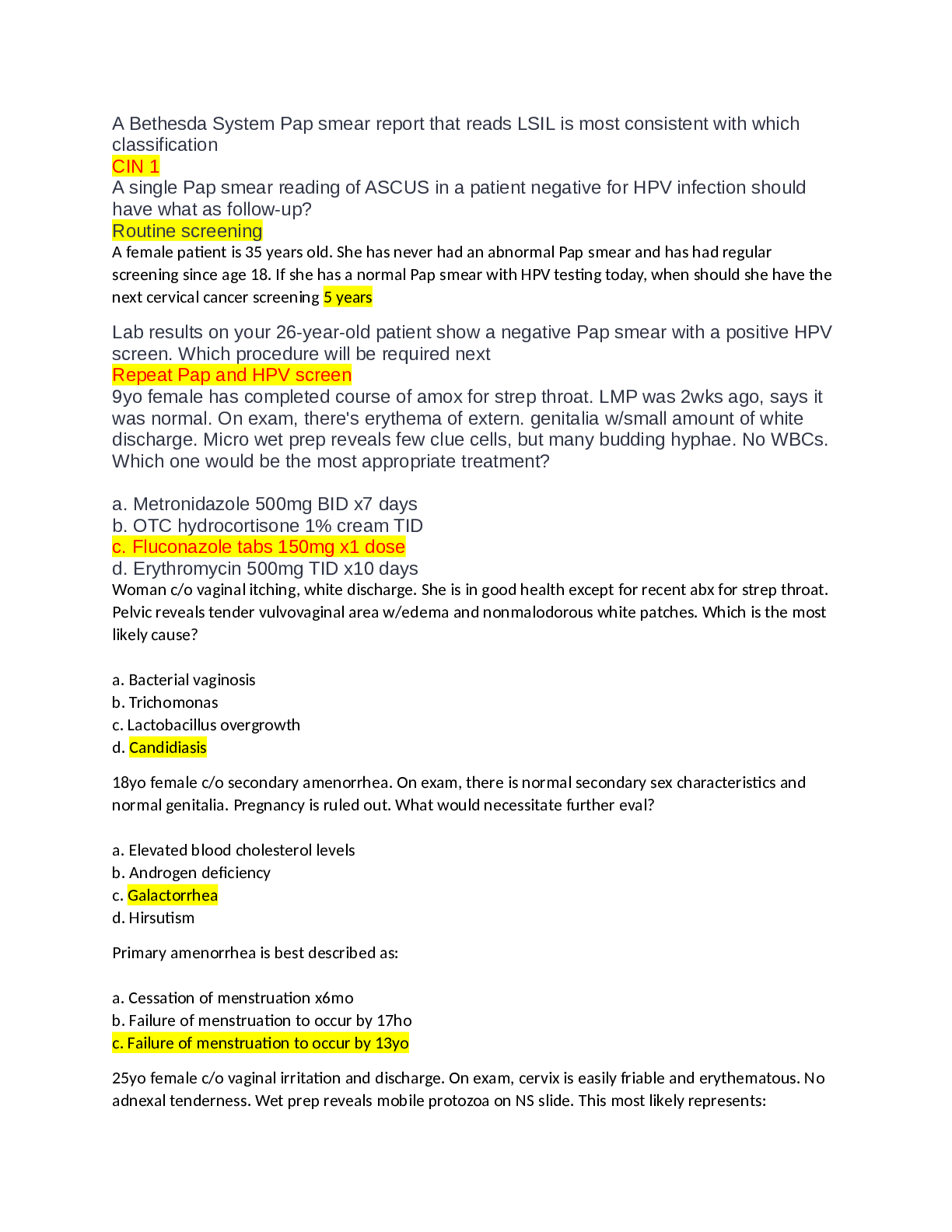

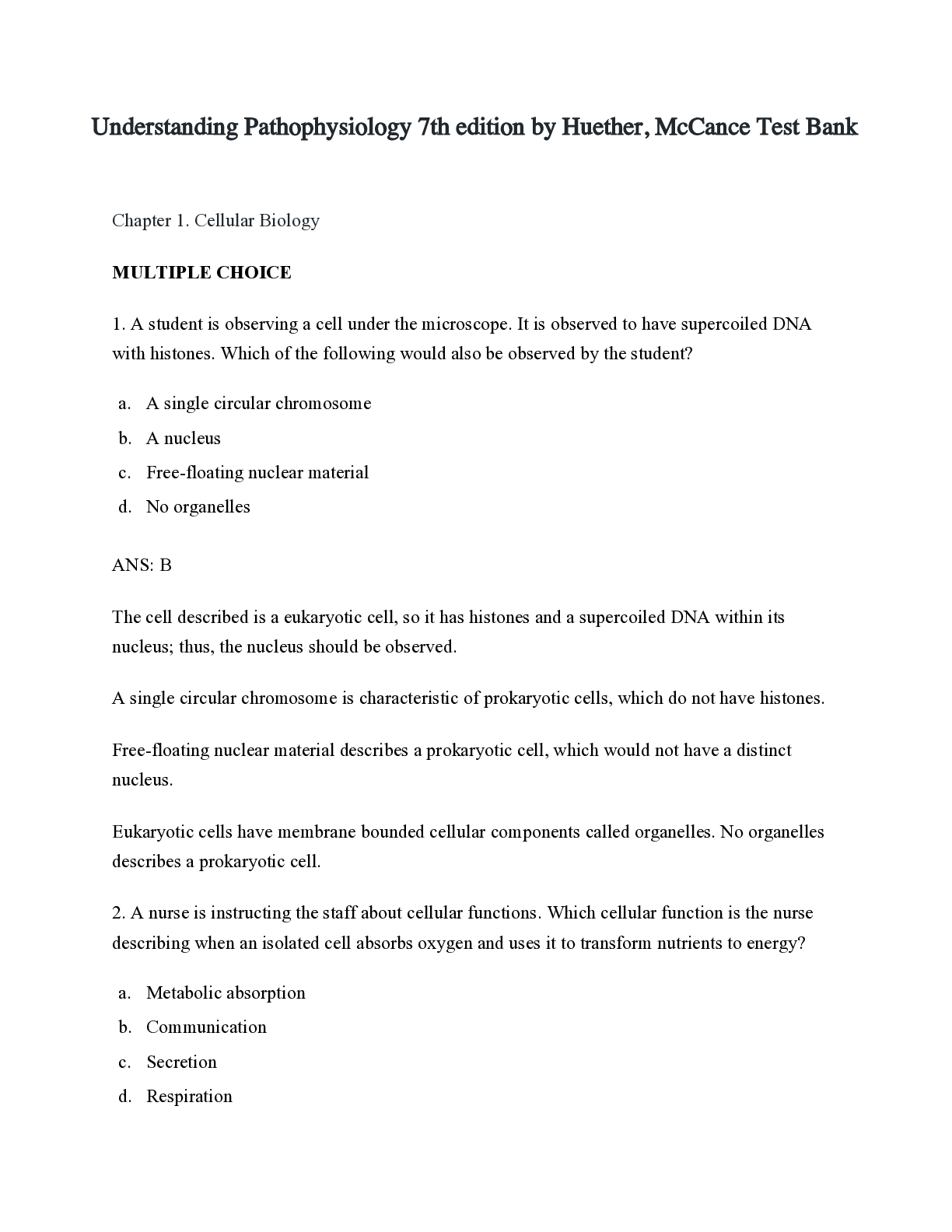
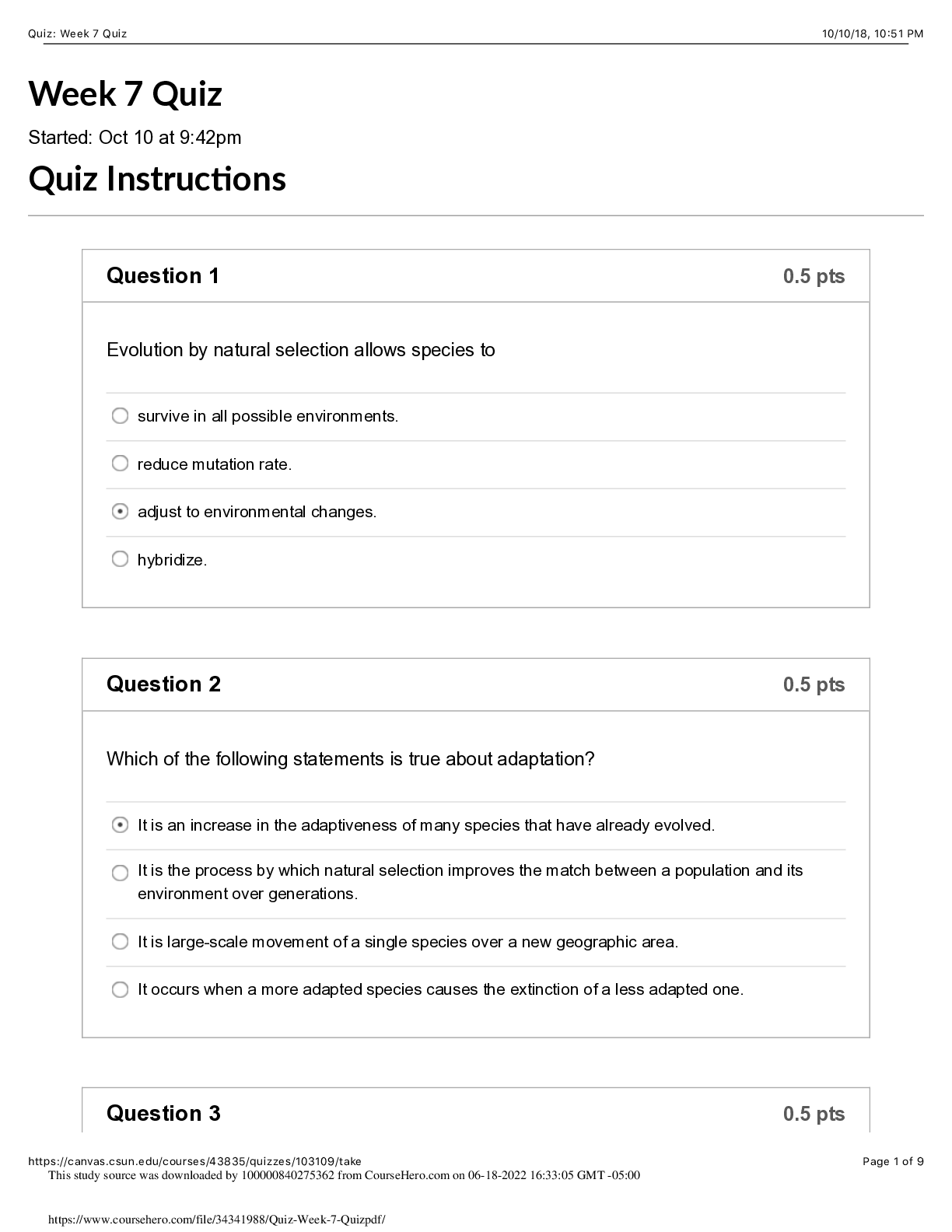
.png)

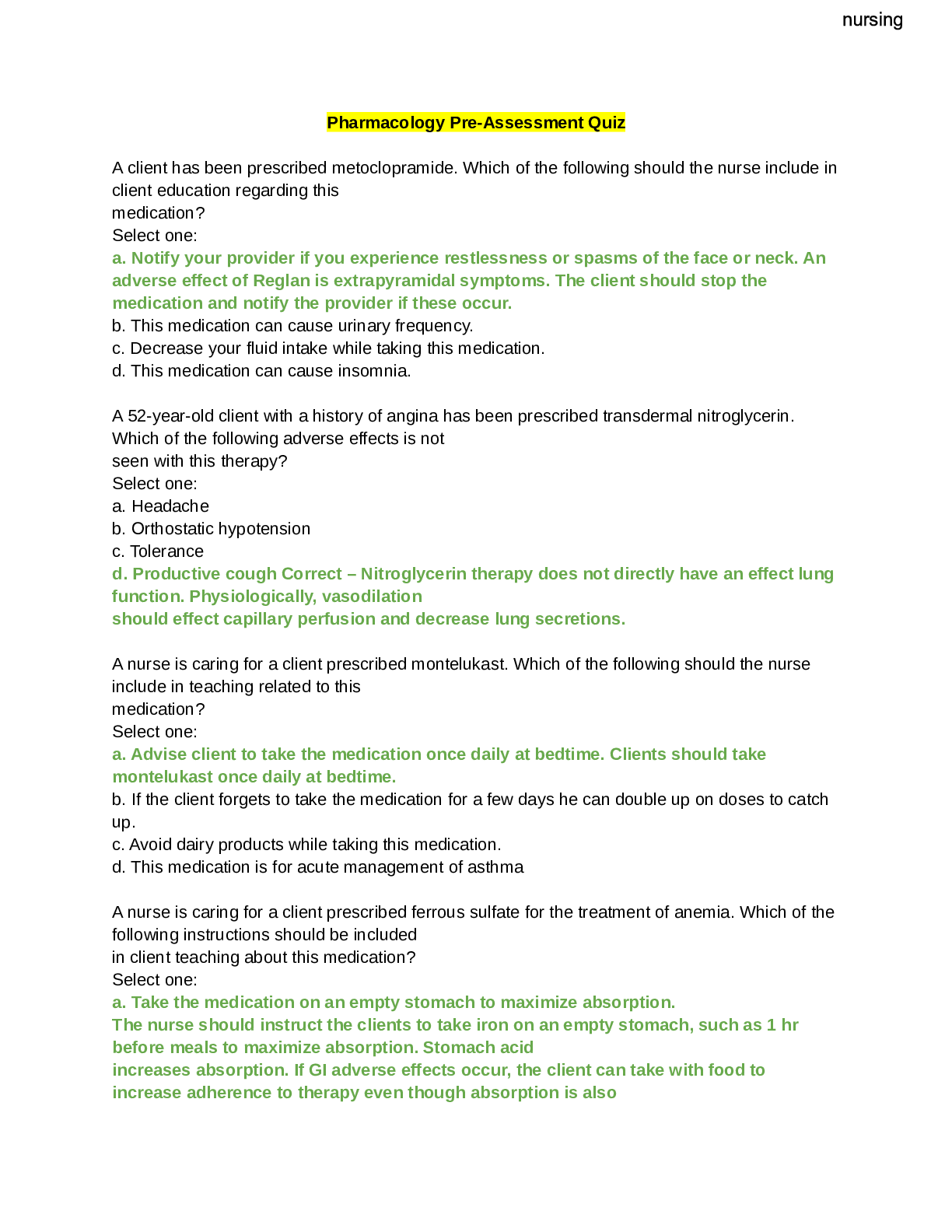
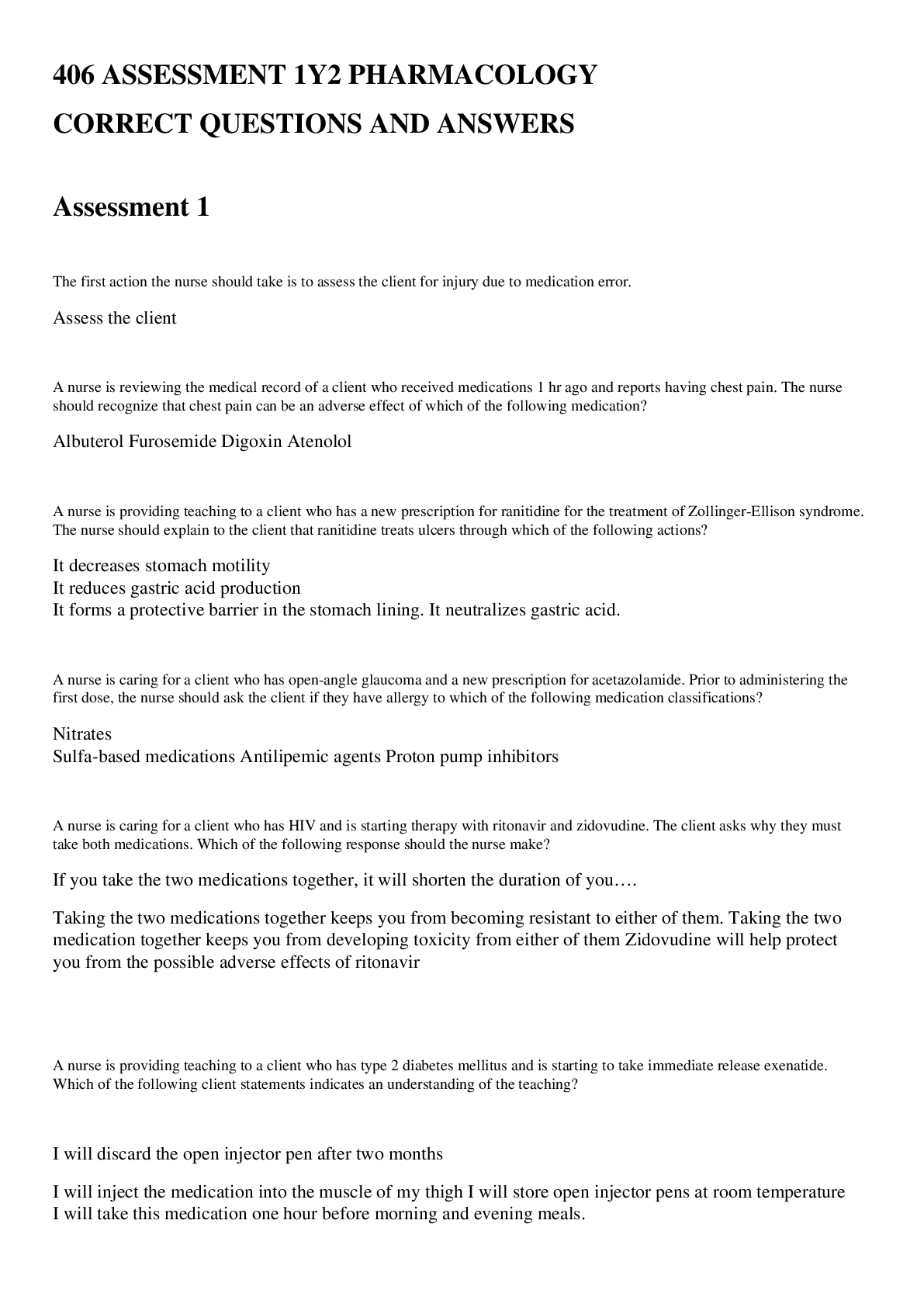

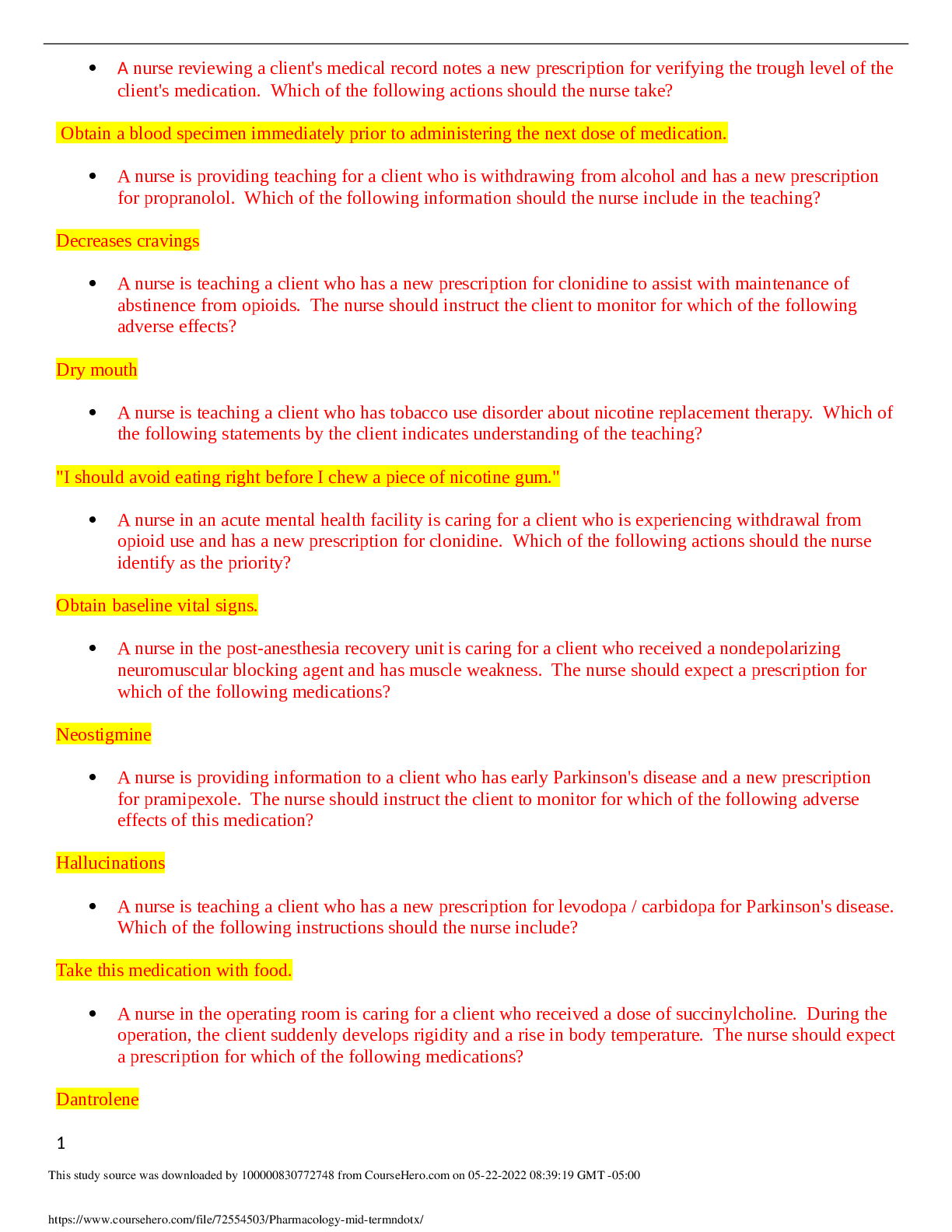
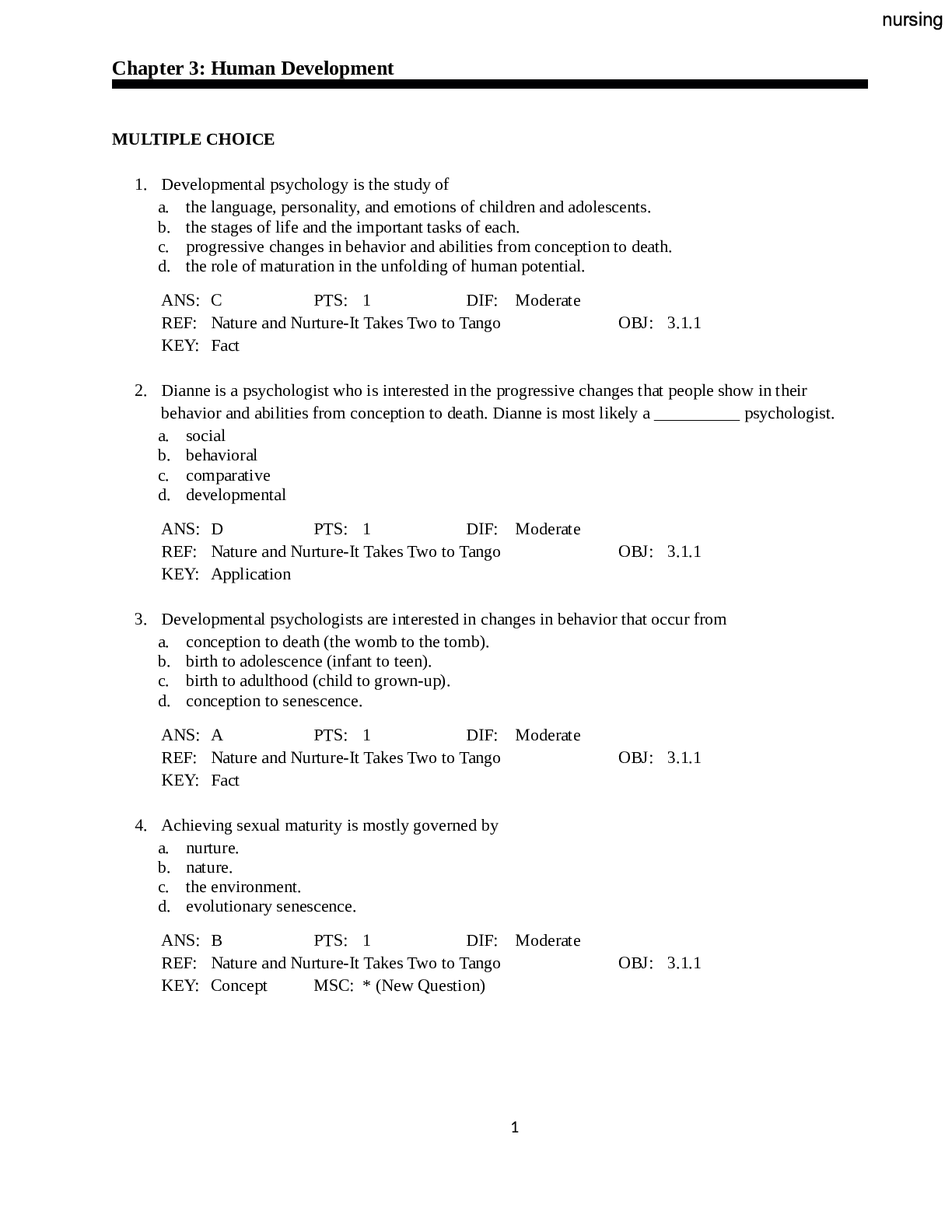


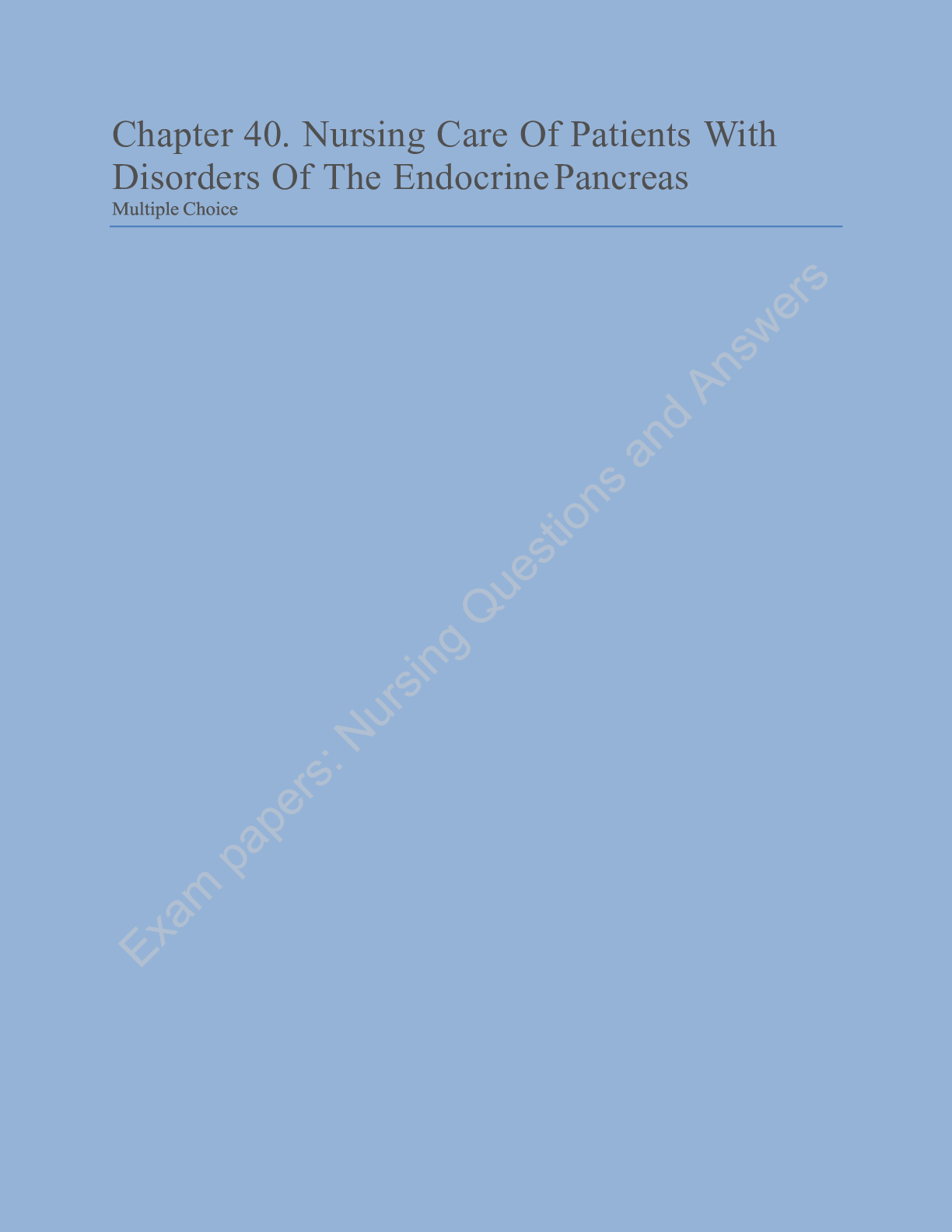

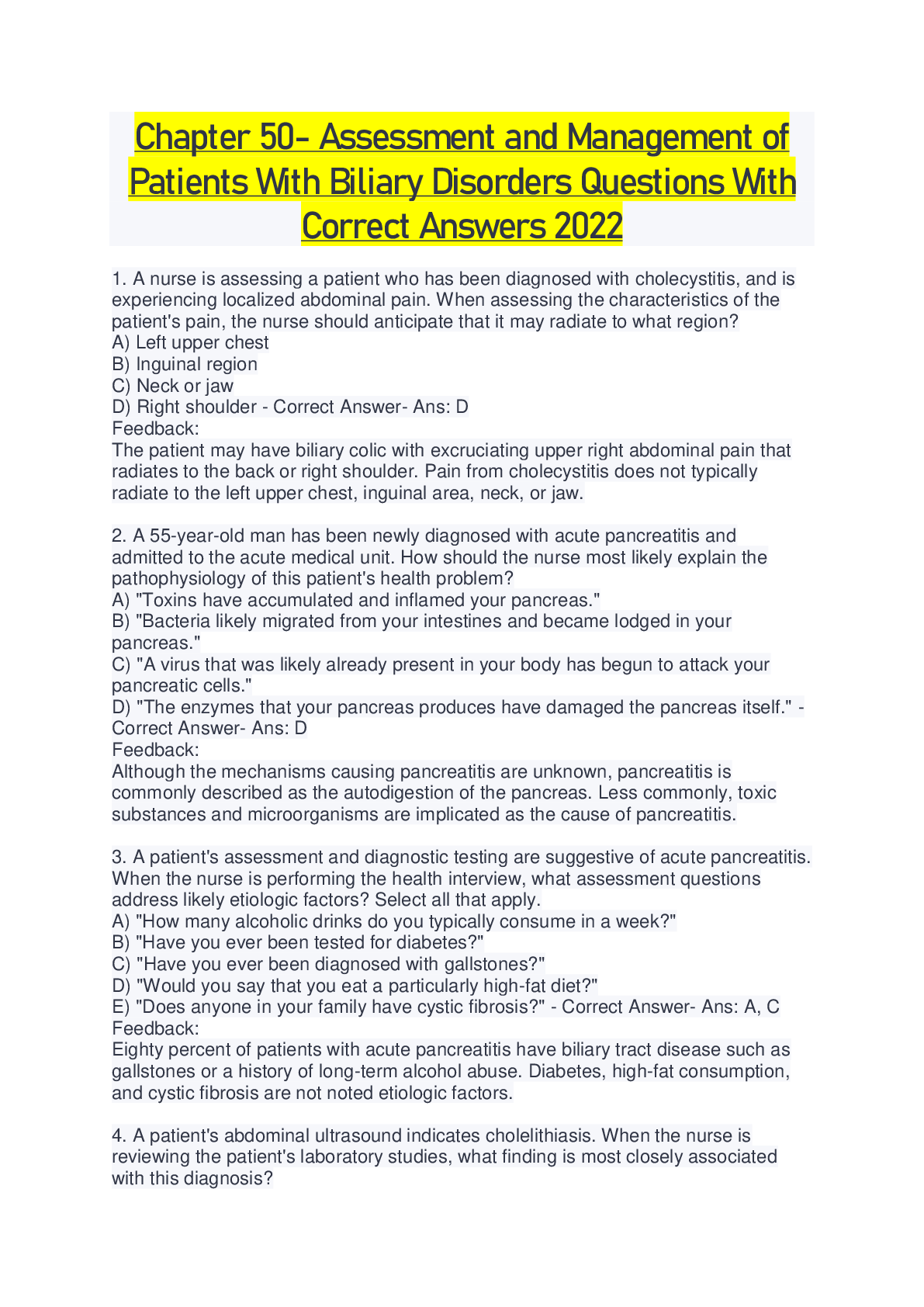
 Med Surg test Latest Verified Questions and all Correct Answers with Explanations Chapter 61 Managements of Patients with Dermatologic Pro.png)
 Med Surg test Latest Verified Questions and all Correct Answers with Explanations Chapter 58 Assessment and Management of Patients with Br.png)
 Med Surg test Latest Verified Questions and all Correct Answers with Explanations Chapter 57 Management of Patients with Female Reproducti.png)
 Med Surg test Latest Verified Questions and all Correct Answers with Explanations Problems Chapter 28.png)
 Med Surg test Latest Verified Questions and all Correct Answers with Explanations Chapter 68 Management of Patients with Neurologic Trauma.png)
 Med Surg test Latest Verified Questions and all Correct Answers with Explanations Chapter 63.png)
 Med Surg test Latest Verified Questions and all Correct Answers with Explanations Chapter 67 Management of Patients with Cerebrovascular D.png)
 Med Surg test Latest Verified Questions and all Correct Answers with Explanations Chapter 69.png)
 Med Surg test Latest Verified Questions and all Correct Answers with Explanations Chapter 66 Management of Patients with Neurologic Dysfun.png)
 Med Surg test Latest Verified Questions and all Correct Answers with Explanations Problems Chapter 27 Management of Patients with Coronary.png)
 Med Surg test Latest Verified Questions and all Correct Answers with Explanations Chapter 71 Management of Patients with Infectious Diseas.png)
 Med Surg test Latest Verified Questions and all Correct Answers with Explanations Chapter 62 Managements of Patients with Burn Injury.png)
 Med Surg test Latest Verified Questions and all Correct Answers with Explanations Chapter 70.png)
 Med Surg test Latest Verified Questions and all Correct Answers with Explanations Chapter 59.png)
 Med Surg test Latest Verified Questions and all Correct Answers with Explanations Chapter 52 Assessment and Management of Patients with En.png)
 Med Surg test Latest Verified Questions and all Correct Answers with Explanations Chapter 54 Management of Patients with Kidney Disorders.png)
 Med Surg test Latest Verified Questions and all Correct Answers with Explanations Chapter 49 Assessment and Management of Patients with Hepatic Disorders.png)

